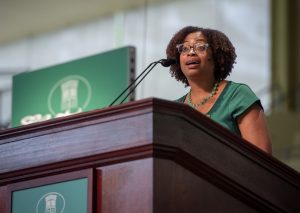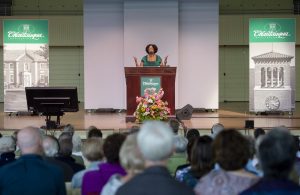
As curator of Latinx studies at the National Museum of African American History and Culture, Ariana A. Curtis advocates for accurate and inclusive historical narratives that depict everyday people, not just the extraordinary.
“Marginalized racial, ethnic and gendered identities do not deserve recognition because one person poked a hole in a racist and patriarchal system to become the first woman, the first black person or the first Latina,” Curtis said. “Our everyday experiences belong as part of our national narratives because we exist.”
At 10:45 a.m. on Thursday in the Amphitheater, Curtis gave her lecture “Creating We: On continuum of Latinx and African American Identity” as part of Week Nine, “Exploring Race and Culture with Wynton Marsalis and Jazz at Lincoln Center.”
The Fulbright scholar began by explaining her own identity as an Afro-Latina and African American from Western Massachusetts, home to the country’s densest population of Puerto Ricans prior to Hurricane Maria. Curtis grew up surrounded by classmates who were the children of immigrants from Europe, Latin America and the Caribbean.
From a young age, Curtis knew that immigrants are not just people of color, that Latinx is not a race and that black people are culturally diverse.
“Those were fundamental truths of human diversity that I grew up with,” she said. “I share them with you now because I have learned over time that experiencing this depth of diversity was unusual.”
Curtis said her experiences are intertwined with her work as a museum curator and have allowed her to tell accurate histories as the first curator of Latinx studies at two different Smithsonian museums.
Curtis joined the Anacostia Community Museum in Washington, D.C., in 2013. Around this time, Anacostia broadened its mission from a focus on African Americans to urban communities, mirroring the national increase of Latinx populations.
“My position as Latino studies curator created an official space not just to talk about Latinx urban populations, both established and emerging, but also to visually display stories and people within multiracial, multiethnic, diverse urban contexts,” Curtis said.
On her first day at Anacostia, when Curtis introduced herself to an older, African American female colleague, the woman threw her hands up and said, “You people have such difficult names.”
“I laugh when people identify me as Latina because of my first name, Ariana,” Curtis said. “My siblings are Bryan, Derrick and Johari. Being Latina had nothing to do with why my African American mother chose the name. She just liked it.”
This colleague, Curtis said, did not see her as part of her community.
“I had assumed an immediate shared sense of belonging based on our mutual blackness,” Curtis said. “What I received from that exchange was a rejection of shared identity and an assignment of Latinx ‘other,’ this refusal to see each other.”
This first day jolted Curtis and prompted her to reexamine allying phrases like “black people” and “people of color.”
“Non-white people do not necessarily know anything about one another’s histories, how to address each other, or even consider themselves in an alliance,” Curtis said. “Those phrases are descriptions, not promises or coalitions.”
Curtis resolved to use her position to answer urgent questions about the relevance of Latinx studies and to showcase the past and present diversity within Washington, D.C.
“For decades, Washington, D.C. was known affectionately as ‘Chocolate City’ because it was predominantly black,” Curtis said. “That chocolate, however, was not all African American.”

In her two exhibits at Anacostia, “Bridging the Americas” and “Gateways/Portales,” Curtis gathered poetry, art, archival recordings, artifacts and photography to highlight Latinx stories, from Afro-Panamanian parades to movements for college access for undocumented students, as well as the Dominican salons where black women gathered to discuss the natural hair movement.
“There were stories of community leaders and political firsts — most of them women, by the way — but the majority of the images in this award-winning exhibition depicted everyday life in urban spaces,” Curtis said.
Although both “Gateways” and “Bridging the Americas” are gone — Anacostia does not have permanent exhibits — Curtis said they allowed the museum staff and the community to see and appreciate the many identities that call D.C. home.
In 2016, Curtis joined the newly opened National Museum of African American History and Culture. Although she was not on staff for the museum’s opening, Curtis was delighted that her colleagues had woven black ethnic diversity throughout the museum, such as the inclusion of Afro-Latinx athletes, politicians and military personnel.
“This inclusive reality sets a didactic and emotional tone for the visitors, the staff, the collection, the programming and the public,” Curtis said. “It represents an institutional decision about how this collection will be built and who this museum will represent.”
In terms of the museum’s representation of Afro-Latinx women, Curtis highlighted two particular artifacts.
The first was a dress worn by Celia Cruz, a black Cuban woman known as the Queen of Salsa. The first time Curtis saw this dress at the NMAAHC, she said her heart skipped a beat.
“I will never suggest that museums do not collect and display material culture from famous women,” Curtis said. “But being extraordinary, like Celia Cruz, is atypical. Singular stories of famous women are aspirational, but do not create a broad base for incorporating women’s history or Afro-Latinx history.”
The second artifact was a wooden boat seat that an Afro-Ecuadorian woman named Débora Nazareno once used to navigate the waterways of Ecuador. It is decorated with a spider and a spider web, representing Anansi or Aunt Nancy, “a character out of West African folklore that traveled via the transatlantic slave trade and rooted in the African Diaspora, including in the United States.”
This object — the very first donated to NMAAHC — is Curtis’ favorite because it breaks patterns by representing an everyday woman’s story without depicting her via a portrait or clothing.
“It is a reminder that no matter the political rhetoric, African American culture, like all U.S. culture, is globally constructed and globally connected,” she said. “The popularity of NMAAHC shows that people worldwide are hungry for alternative perspectives of our shared history.”
Those visiting Curtis’ galleries may never know they were curated by an Afro-Latina woman. Although Curtis’ exhibitions are not authored, she said her curatorial voice matters.
“To borrow language from Wynton Marsalis’ talk on Monday morning, I have a responsibility to not lie to myself about what being a black Latina curator means, both in challenge and reward,” Curtis said.
Curtis said her experiences at black museums are not representative of her field, where white men make up 93% of museum directors and 89% of board members, according to a 2018 study.
“We know that public history perspectives are overwhelmingly white and male,” Curtis said. “You have heard of #OscarsSoWhite. Well, #MuseumsSoWhite is also a thing.”
Another study Curtis cited found that Americans across all ages, races and geographical locations consider museums the most trustworthy source of information, above local papers, nonprofits and academic researchers.
“So museums’ trustworthiness exists despite movement from within the museum field to openly acknowledge that museums are not neutral,” she said. “The reality of who is telling the story matters in what stories are being told. It matters to how the stories are told.”
Although she is an introvert, Curtis said she feels it is important for her to discuss her experiences with racism, microaggressions and exclusion. She also feels responsible for documenting a diversity of people, not just the white or famous.
“Museums can literally change how millions of people see women and which women they see,” Curtis said. “To be clear, it is not only important that I see myself in official public narratives like those of museums. It is equally as important that you see me.”

